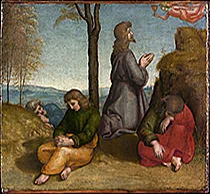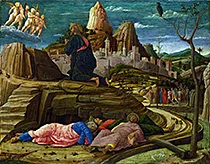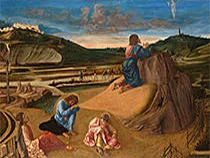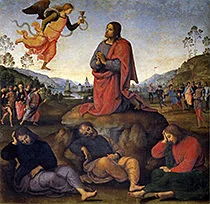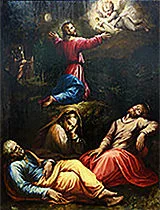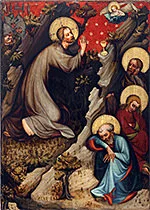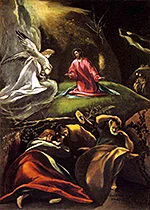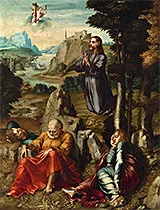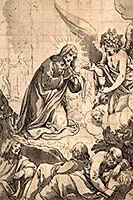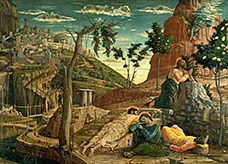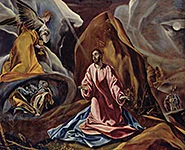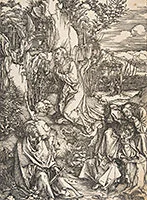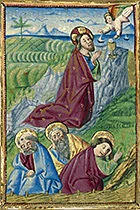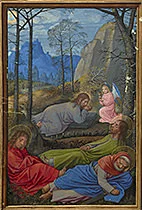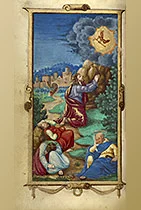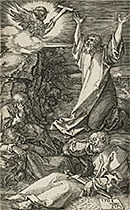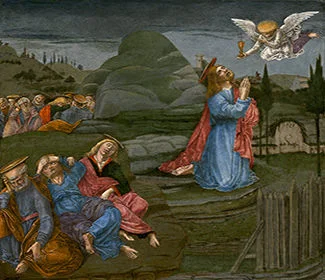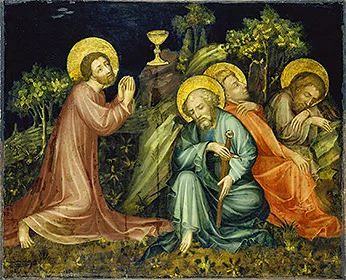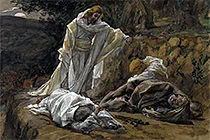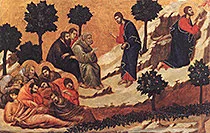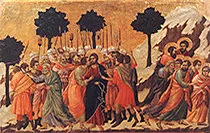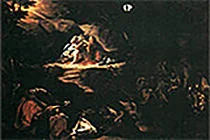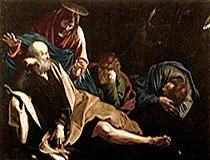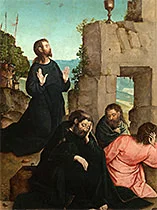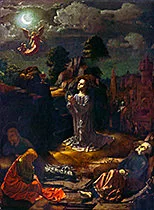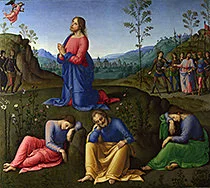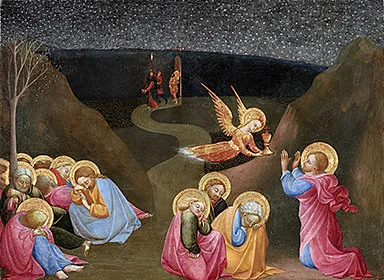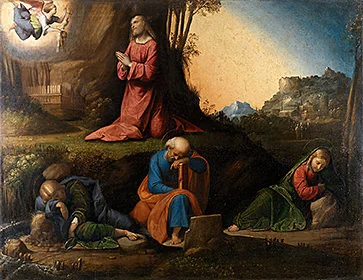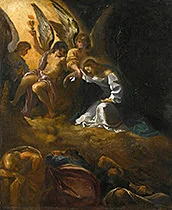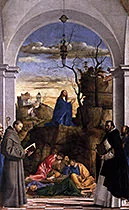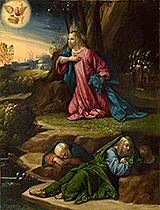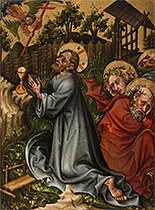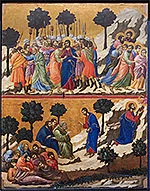The Art World Commemorates Peter
— Album 13 of 17 Photo Albums —
Warren Camp’s presentation of 550 famous “Peter” works of art includes historic paintings, frescoes, stained glass, etchings, sculptures, engravings, and other artwork monuments. They come from the Gothic (1100–1400), High Renaissance, Baroque, Rococo, Neoclassical, and Romantic (1800s) eras.
All are popular works, designed and created by celebrated artists, many of whom you’ll likely recognize, including Rembrandt, Raphael, Michelangelo, El Greco, Da Vinci, Masaccio, Huret, Galle, Tissot, Botticelli, Dürer, Rubens, and many more. They’ll bring back recollections of your “Art History 101” classes, using Janson’s History of Art textbook.
Whether depicting “Cephas,” “Petrus,” “Simon,” “Simeon,” “Simon Bar-Jonah,” “Simon Peter,” “The Rock,” “Peter,” “Apostle Peter,” or “Saint Peter,” the enlarged images of this acclaimed Bible figure come with factual and enlightening details: the artist’s bio; when each work was created; where it can be seen; applicable Bible passages; background and highlights of each work; and photo sources with copyright notices.
To appreciate the impact that Peter had on numerous art-world masters, be sure to click each thumbnail to enlarge it.
• These photo albums complement the Bible-study commentaries Warren has written for “1st and 2nd Peter,” found here.
…
Album 1 (Peter, alone) | Album 2 | Album 3 | Album 4 | Album 5
Album 6 | Album 7 | Album 8 | Album 9 | Album 10 | Album 11
Album 12 | Album 13 | Album 14 | Album 15 | Album 16 | Album 17
Album topics are shown at the [ ⇓ bottom ⇓ ] of each page.
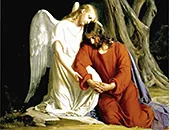
Christ’s Agony on the Mount of Olives
Slide 18
Click to enlarge.
Nuremburg Master of the Altarpiece of the Virgin
1520–1530, mixed media on wood, then canvas
One Hour with Me”
Slide 19
Click to enlarge.
Tissot — 1886–1894
watercolor on paper
Mount of Olives”
(Maestà)
Slide 20
Click to enlarge.
Duccio — c. 1309
tempera on panel
Jesus’ Betrayal”
(Maestà)
Slide 21
Click to enlarge.
Duccio — c. 1309
tempera on panel
Mount of Olives”
Slide 25
Click to enlarge.
Gossaert — c. 1509
oil on oak panel
- 1. “The Agony in the Garden,” oil on wood, by Raphael, c. 1504
Raphael (Raffaello Sanzio or Santi, 1483–1520) “This ‘Agony in the Garden’ panel was originally part of the base of the Colonna altarpiece, one of three scenes focusing on Christ’s last days. Here, Christ prays prior to his arrest while his disciples slumber around him. The small angel who proffers a chalice or cup is a visualization of Christ’s thoughts — ‘My Father, if it is possible, may this cup be taken from me. Yet not as I will, but as you will’ (Matthew 26:39b) — as he slowly accepts his fate. Raphael depicts the scene in a delicate landscape, with each of the sleeping followers in a carefully observed pose.”[1]
Raphael’s painting shows the kneeling figure of Christ, praying on the Mount of Olives, prior to his arrest and ensuing Passion. He’s accompanied by his apostles, Peter, James, and John [l. to r.], all of whom — despite Christ’s repeated pleas — had fallen asleep. According to Luke’s gospel: “An angel from heaven appeared to him and strengthened him. And being in anguish, he prayed more earnestly, and his sweat was like drops of blood falling to the ground” (Luke 22:43–44).
In the Garden of Gethsemane was an olive press, situated inside a grove of olive trees. Jesus, being “the anointed one,” was anointed with olive oils. To have been set apart as the King of Israel, he was to be anointed with holy olive oil. See and appreciate the relevance and importance of anointing in this crushing of olives video. Also see Raphael’s pen-and-ink drawing of this painted scene.
… Height: 9 1/2 in. (24.1 cm), width: 11 3/8 in. (28.9 cm)
… Photo source, license, attribution, museum details, and image enlargement: The Met; funds from various donors, 1932
… The artist’s short biography; his other works of art
Return to “Peter Masterpieces” album’s opening page or to the top of this page or open the next album. - 2. “Agony in the Garden,” tempera on wood, painted by Andrea Mantegna, 1458–1460
Andrea Mantegna (1431–1506) “was an Italian painter, a student of Roman archeology, and son-in-law of Jacopo Bellini.”[1] Bellini is considered to have been inspired by this painting for his own rendering of Agony in the Garden, painted between 1460 and 1465 [highlighted in the next slide]. Both paintings are displayed side by side at the National Gallery, London. Another like-kind painting by Mantegna, composed in the reverse, appears on slide 10.
“Christ prays before a group of cherubs on a cloud who hold up the instruments of his torture and death. His disciple, Judas (right-center), who has betrayed him, leads a large band of soldiers down from Jerusalem to arrest him. Meanwhile, three of his other disciples sleep [Peter, left, in blue]. This painting reflects many of the artistic issues that would preoccupy Mantegna throughout his career. He was fascinated by the art of classical antiquity: The disciples here look like statues of Roman emperors in togas, one of whom lies with his legs facing straight out at the viewer, a difficult pose to paint; Mantegna enjoyed experimenting with it for its ability to draw us into the picture.
“Mantegna skilfully uses the landscape setting to tell the story in a single image; the march of the soldiers from the city gates creates drama and suggests the passage of time. He works with his favored fast-drying egg tempera paint to describe minute details like the individual bricks of the city walls.”[2]
… Height: 24.8 in. (62.9 cm), width: 31.5 in. (80 cm)
… Photo source, license, attribution, museum details, and image enlargement: Andrea Mantegna, public domain, via Wikimedia Commons
… The artist’s short biography; his other works of art
Return to “Peter Masterpieces” album’s opening page or to the top of this page or open the next album. - 3. “The Agony in the Garden,” tempera on panel, painted by Giovanni Bellini, c. 1459–1465
This Agony in the Garden was painted by Giovanni Bellini (1430–1516). He and his brother-in-law, Andrea Mantegna [see previous slide], were two of the greatest artists of the early Renaissance. “Bellini was considered to have revolutionized Venetian painting, moving it toward a more sensuous and coloristic style. Through the use of clear, slow-drying oil paints, he created deep, rich tints and detailed shadings. His sumptuous coloring and fluent, atmospheric landscapes had a great effect on the Venetian painting school, especially on his pupils, Giorgione and Titian.”[1]
“This painting depicts the common religious theme of Christ’s time of prayer in the Garden of Gethsemane, on the Mount of Olives, before being taken prisoner, as a result of Judas’ betrayal. In this version, Christ kneels in prayer at a rock mound while his disciples — Peter, James, and John — sleep on the ground behind him. Visible in the clouds above the kneeling Jesus is an angel, holding a cup and a plate of bread as symbols of Christ’s upcoming sacrifice. In the distance, beyond the three foreground figures, soldiers, high priests, Pharisees, and servants wind their way along the road, with Judas in the lead.”[2]
Bellini’s Agony in the Garden “is often compared to an earlier painting on the same subject [see previous slide] by his brother-in-law, Mantegna, whose landscape is, by comparison, dramatic and somewhat cramped, and heavily populated by angels and soldiers in close proximity.”[3] “For seven years, Bellini and Mantegna worked in close creative dialogue. Neither’s career or artistic development would have existed without the other, and without these works imbued with their creativity and innovation, Renaissance art, by the likes of Titian, Correggio, and Veronese, would not exist as it does today.”[4]
… Height: 31.9 in. (81 cm), width: 50 in. (127 cm)
… Photo source, license, attribution, museum details, and image enlargement: Giovanni Bellini, public domain, via Wikimedia Commons
… The artist’s short biography; his other works of art
Return to “Peter Masterpieces” album’s opening page or to the top of this page or open the next album.
- 4. “Agony in the Garden,” oil on panel, painted by Pietro Perugino, 1483–1493
Because his nickname characterizes him as coming from Perugia (the chief city of Umbria), Pietro Perugino (1448–1523), “born Pietro Vannucci, was an Italian Renaissance painter of the Umbrian school, who developed some of the qualities that found classic expression in the High Renaissance. Raphael was his most famous pupil. Perugino was one of the earliest Italian practitioners of oil painting.”[1]
“Christ is portrayed in the center, kneeling in Gethsemane and receiving from an angel a divine chalice [which the gospels present as the agonizing, imminent completion of Jesus’ human destiny]. His figure forms a triangle with the three sleeping apostles at the bottom (from the left, John, Peter, and James); the triangle is connected to the painting’ sides by the symmetrical line of the hills. Behind Jesus is a lake landscape, a typical element of the Italian painting at the time, with a fortified city and an ancient bridge. At the sides, two groups of soldiers, one led by Judas Iscariot, are closing in to arrest Jesus.”[2]
“The garden at Gethsemane, a place whose name literally means ‘oil press,’ is located on a slope of the Mount of Olives just across the Kidron Valley from Jerusalem. Jesus frequently went to Gethsemane with His disciples to pray (John 18:2). The most famous events at Gethsemane occurred on the night before His crucifixion when Jesus was betrayed. Each of the gospel writers describes the events of that night with slight variations, so reading the four accounts (Matthew 26:36–56; Mark 14:32–52; Luke 22:39–53; and John 18:1–11) will give an accurate picture of that momentous night in its entirety.”[3]
… Height: 65.3 in. (166 cm), width: 67.3 in. (171 cm)
… Photo source, license, attribution, museum details, and image enlargement: Pietro Perugino, public domain, via Wikimedia Commons
… The artist’s short biography; his other works of art
Return to “Peter Masterpieces” album’s opening page or to the top of this page or open the next album. - 5. “Garden of Gethsemane,” oil on panel, painted by Giorgio Vasari, c. 1570
Giorgio Vasari’s “Garden of Gethsemane” is an “Italian Renaissance and Mannerist oil-on-panel painting created in 1570. It lives at the National Museum of Western Art, Tokyo.”[1] The Mannerist style can be seen in the richly varied forms and the composition’s flowing dynamism and tension. Judas (upper-left) leads the crowd who will arrest Christ, which is traditional iconography for this “agony in the garden” subject.
Jesus, aware of Judas’ upcoming act of betrayal, walked to Gethsemane’s garden, on a slope of the Mount of Olives. There in the garden, separated from the Eleven, his three trusted disciples — Peter, James, and John — accompanied Christ but they fell asleep. The night before he was crucified, Jesus prayed to Father God. Having moved a distance from the three men to pray, he twice asked his Father to take from him the cup of wrath that he was about to drink. He was “overwhelmed with sorrow to the point of death” (Matthew 26:38 NIV) but God sent an angel (shown above) from heaven to strengthen him.
“The events that occurred in the Garden of Gethsemane have reverberated down through the centuries. Even our language has been affected by these events, giving us such phrases as: ‘he who lives by the sword dies by the sword’ (Matt. 26:52); ‘the spirit is willing, but the flesh is weak’ (Mark 14:38); and “sweating drops of blood’ (Luke 22:44). The most important impact of this night was our Savior’s willingness to die on the cross to pay the penalty for our sins. God ‘made Him who knew no sin, to be sin for us, that we might become the righteousness of God in Him’ (2 Corinthians 5:21). This is the gospel of Jesus Christ.”[2]
… Height: 56 1/2 in. (143.5 cm), width: 50 in. (127 cm)
… Photo source, attribution, museum details, and image enlargement: Giorgio Vasari, public domain, via Obelisk Art History
… The artist’s short biography; his other works of art
Return to “Peter Masterpieces” album’s opening page or to the top of this page or open the next album. - 6. “Christ on the Mount of Olives,” oil on panel, painted by Master of the Třeboň Altarpiece, c. 1380
The Master of the Třeboň Altarpiece who painted this altarpiece panel titled Christ on the Mount of Olives “was a Bohemian painter, active in Prague from 1380–1390. His name is derived from the Třeboň Altarpiece in the church of Saint Eligius at the Augustinian convent of Třeboň. The triptych [three-part altarpiece] depicts: (1) Christ on the Mount of Olives, (2) The Tomb of Christ, and (3) The Resurrection. Dated c. 1380, today it’s held at the Convent of St Agnes branch of the National Gallery in Prague.”[1]
“The quality of the Třeboň Altarpiece’s painting is without parallel. It represents the technological pinnacle of European painting in the late-14th century. The panels are composed of spruce boards joined by pegs, covered on both sides with canvas. The composition is dominated by the striking diagonal of rock faces that divide the central figure of Christ from the two accompanying scenes: the sleeping apostles in the foreground and Judas [unhaloed] in the background, bringing the soldiers. The praying Christ has drops of bloody sweat (Luke 22:44) and the angel presents him with the Cup of Bitterness.”[2]
What happened on the Mount of Olives? “The Mount of Olives was the site of many events in the Bible. Jesus made several visits there. The Bible records his visiting there three times in the last week of His earthly life, and each time something of significance happened: (1) his triumphal entry; (2) his deliverance of the Olivet Discourse; and (3) his betrayal.”[3]
… Framed height: 52 in. (132 cm), width: 36 1/4 in. (92 cm)
… Photo source, license, attribution, museum details, and image enlargement: Master of Wittingau, public domain, via Wikimedia Commons
… The artist’s short biography; his other works of art
Return to “Peter Masterpieces” album’s opening page or to the top of this page or open the next album. - 7. “The Agony in the Garden,” oil on canvas, painted by El Greco, c. 1608
Agony in the Garden is one of many oil-on-canvas paintings by El Greco and his workshop. “Many can be seen in the Church of Santa María in Andújar, Spain; Diocesan Museum, Cuenca, Spain; Szépmûvészeti Múzeum, Budapest ; and in Buenos Aires.
“The Agony in the Garden was one of his most successful inventions. He painted the subject both as a horizontal [shown on slide 11] and as a vertical composition [see previous paragraph]. This vertical version, in the Budapest museum, is not only smaller but also considerably more vertical, yielding a heightened tension and augments the emotional impact of the scene. In his religious compositions and portraits, El Greco frequently repeated themes from his major works, with slight alterations, to meet different commissions. This Agony in the Garden is representative of his late years and mature style.”[1]
“At the top of this work are Christ and an angel, with the apostles James, John, and Peter [l. to r.] sleeping at the bottom. Judas approaches in the right-hand background.”[2]
El Greco’s representation of Jesus in agony in Gethsemane was reproduced on this 1969 airmail postage stamp from Ajman (UAE).
… Height: 66.9 in. (170 cm), width: 44.2 in. (112.5 cm)
… Photo source, license, attribution, museum details, and image enlargement: El Greco, public domain, via Wikimedia Commons
… The artist’s short biography; his other works of art
Return to “Peter Masterpieces” album’s opening page or to the top of this page or open the next album. - 8. “The Agony in the Garden,” oil on panel, painted by Luis de Morales, 1545
Luis de Morales (1510–1586) Recognized as Spain’s greatest mannerist painter, Morales produced mostly small pictures that summoned inspiration from religious motifs.” “He was a Spanish painter active during the Spanish Renaissance in the 16th century. Known as ‘El Divino,’ most of his work was of religious subjects. He was called by his contemporaries ‘The Divine Morales’ because of his skill, the shocking realism of his paintings.”[1]
“As a master of altarpieces, Luis de Morales’s most important work was produced in the 1540s and 1550s.”[2] See many of his paintings of Jesus here.
“Christ’s prayer on the Mount of Olives is the gospel episode that precedes his arrest and the beginning of his Passion and death on the cross. After his last supper with his disciples, Jesus withdrew with three of them — Peter and the two sons of Zebedee, James and John — to the nearby garden in Gethsemane. There appeared an angel from heaven, strengthening him. Being in an agony he prayed more earnestly; he sweated as if drops of blood were falling to the ground. When he rose from prayer and came to his disciples, he found them sleeping. Morales composed his Agony in the Garden using many of its usual representations, situating Jesus atop a small knoll where he kneels in prayer and contemplates the angel bearing a chalice and a cross, while James, Peter, and John sleep soundly in the foreground.”[3]
… Height: 33 1/2 in. (85 cm), width: 25 3/4 in. (65.5 cm)
… Photo source, license, attribution, museum details, and image enlargement: Museo del Prado
… The artist’s short biography; his other works of art
Return to “Peter Masterpieces” album’s opening page or to the top of this page or open the next album. - 9. “The Agony in the Garden,” pen-and-ink drawing, by Caspar Strauss, 1600–1633
Very little can be found about Caspar Strauss (German, 1595–1663). This pen and black ink and gray wash (squared in red chalk) drawing was created by Strauss between 1600 and 1633.
The gospels contain an account of the time the disciples and Jesus spent in the Garden of Gethsemane (Hebrew for “olive press”), just before Jesus was arrested. Caspar Strauss encouraged the viewer to identify with Jesus in his Agony in the Garden drawing. To heighten the emotional tension of this scene from Christ’s Passion, the artist compressed three events into this single scene. In the foreground the apostles have fallen asleep despite Jesus’ request that they keep watch. While Peter (front-right) lies clutching the handle of his sword in hand, he appears significantly labored in this pen-and-ink drawing.
In the center of the drawing, haloed Jesus prays to God as we see the suggestion of soldiers in the left-background approaching for Jesus’ upcoming arrest. Strauss emphasized Jesus’ emotional isolation during prayer by showing him being approached by an angel accompanied by cherubim in clouds. The angel reaches out to Jesus while holding a cup in the other hand. “In Gethsemane’s garden, Jesus prayed to his Father three times, saying, ‘My Father, if it is possible, may this cup be taken from me. Yet not as I will, but as you will.’ (Matthew 26:39). A little later Jesus prayed, ‘My Father, if it is not possible for this cup to be taken away unless I drink it, may your will be done’ (v. 42). These prayers reveal Jesus’ mindset just before the crucifixion and His total submission to God’s will.”[1]
… Height: 9 1/2 in. (24.2 cm), width: 7 1/4 in. (18.4 cm)
… Photo source, license, attribution, museum details, and image enlargement: Giotto, public domain, via The Met; Van Day Truex Fund, 2005
Return to “Peter Masterpieces” album’s opening page or to the top of this page or open the next album. - 10. “The Agony in the Garden,” tempera on wood, painted by Andrea Mantegna, 1457–1459
Andrea Mantegna (1431–1506) “was an Italian Renaissance painter, a student of Roman archeology, and son-in-law of Jacopo Bellini.”[1] Mantegna previously painted another Agony in the Garden rendition (1455–1456; composed in the reverse), which Warren Camp highlights in this “Peter Masterpieces” album: See slide 2 on this page to compare both renderings.
This version of Agony in the Garden is the left panel of the triptych San Zeno Altarpiece, which is in the main church in Verona, Italy. “The three predella panels, stripped by the French in 1797 during Napolean’s reign, along with the main picture (restored to Verona in 1815), have been replaced by copies. The originals are in the Louvre (‘Crucifixion’) and the Musée des Beaux-Arts in Tours, France (‘Resurrection’ and ‘Agony in the Garden’). This version [above] was probably the first good example of Renaissance art in Verona.”[2]
“Mantegna skilfully uses the landscape setting to tell the story in a single image; the march of the soldiers, led by Judas Iscariot, from the city gates creates drama and suggests the passage of time. He uses his favored fast-drying egg tempera paint to describe minute details, such as the individual bricks of the city walls.”[3]
… Height: 25.9 in. (66 cm), width: 34.6 in. (88 cm)
… Photo source, license, attribution, museum details, and image enlargement: Andrea Mantegna, public domain, via Wikimedia Commons
… The artist’s short biography; his other works of art
Return to “Peter Masterpieces” album’s opening page or to the top of this page or open the next album. - 11. “The Agony in the Garden of Gethsemane,” oil on canvas, painted by El Greco, c. 1590
El Greco “(medieval Castilian for ‘the Greek’) is the name by which Domênikos Theotokópoulos de Candia (1541–1614), a Greek-Spanish painter, sculptor, and architect of the Spanish school, is best known. He was a painter in Crete, where he was born, and first trained as a Christian icon painter. At the age of twenty-six, he journeyed to Venice and to Rome where he studied under Titian. In 1577, he emigrated to Toledo — then the ecclesiastical capital of Spain — where he produced his mature works and led a successful career as a painter of altarpieces and portraits. Many of El Greco’s works are on display at Madrid’s Museo del Prado.”[1] El Greco and his workshop painted this Agony in the Garden tableau numerous times, in both vertical and horizontal orientations. A vertical rendition can be seen on slide 7.
This work by El Greco is a scene of Christ in torment, moments before his arrest — at the right we can see Judas Iscariot with the soldiers who are coming to arrest him. The gospel accounts tell us that Christ retreated to a “place called Gethsemane” (Matthew 26:36; Mark 14:32; John 18:1) or “the Mount of Olives” (Luke 22:39) to pray; there he asked God to spare him the “cup of suffering” that he knew awaited him. El Greco places an angel (left), shrouded in supernatural light that’s stronger than the moonlight (upper-right), who presents Christ with that cup. Beneath the angel we see Christ’s three apostles — James, John, and Peter — asleep.
… Height: 40.5 in. (103 cm), width: 51.9 in. (132 cm)
… Photo source, license, attribution, museum details, and image enlargement: Wikimedia Commons
… The artist’s short biography; his other works of art
Return to “Peter Masterpieces” album’s opening page or to the top of this page or open the next album. - 12. “The Agony in the Garden,” woodcut on paper, by Albrecht Dürer, undated
Albrecht Dürer (1471–1528) “was a German painter, printmaker, and theorist of the German Renaissance. He established his reputation and influence across Europe in his twenties due to his high-quality woodcut prints. He was in contact with the major Italian artists of his time, including Raphael, Giovanni Bellini, and Leonardo da Vinci.”[1] See hundreds of Albrecht Dürer woodcuts.
“This “Agony in the Garden” print is one of a set of 12 woodcuts that tell the story of the Crucifixion and Passion of Christ. Dürer’s ‘Large Passion’ series is a vivid and animated rendering of the gospel story. In this scene, Christ kneels and prays in Gethsemane (Hebrew for “olive press”) while his disciples sleep. In anguish he asks God whether he can be spared the coming ordeal, saying, ‘Father, if you are willing, take this cup from me; yet not my will, but yours be done’ (Luke 22:42). In the background, soldiers guided by Judas, are already advancing to arrest Jesus.”[2]
Jesus warned his disciples that if they didn’t remain alert, they’d make a costly mistake. He took them to a place called Gethsemane to spend time in prayer. As he prayed, Jesus experienced a grief and sadness such as he’d never known in his earthly life. He asked Peter, James, and John to stay awake, pray, and “keep watch” with him. But they fell asleep (Matthew 26:38–41). In the agonizing hour of Christ’s greatest need, the disciples lacked spiritual vigilance.
… Height: 15 3/8 in. (39.1 cm), width: 10 15/16 in. (27.8 cm)
… Photo source, license, attribution, museum details, and image enlargement: Albrecht Dürer, public domain, via The Met; gift of Henry Walters, 1917
… The artist’s short biography; his other works of art; Dürer’s collection of thirty-six “Small Passion” woodcuts and twelve “Large Passion” woodcuts
Return to “Peter Masterpieces” album’s opening page or to the top of this page or open the next album. - 13. “The Agony in the Garden,” manuscript in the Book of Hours, unknown artist, c. 1460
Some of the greatest paintings and drawings of the late Middle Ages and early Renaissance aren’t displayed on church and museum walls; instead, they shine forth from the pages of books. This 13th-century tempera colors, gold, and ink on parchment manuscript titled The Agony in the Garden is found in one of many “books of hours.” The author/creator of this Book of Hours and its manuscripts is unknown, however, they were created in Naples, Italy, c. 1460. These manuscripts, with their text in Latin, were among the most widely produced and used during the Middle Ages. They were decorated prayer books that not only enabled structured prayer time for their readers (over a day, a year, and a lifetime) but their creation reveals an increasing demand for private and personalized Christian devotion. See the entire manuscript collection of this Book of Hours, compliments of The J Paul Getty Museum.
Christ and his eleven remaining disciples entered the garden in Gethsemane. Jesus asked eight of the eleven apostles to sit while he went on into the garden to pray with Peter and the two sons of Zebedee, James and John, as we learn from the gospels (Matthew 26:36–46; Mark 14:32–42; Luke 22:39–46). Jesus asked the three to keep watch and pray that they wouldn’t fall into temptation. Alas, they fell asleep. Anticipating his crucifixion, Jesus prayed: “Father, if you are willing, take this cup from me; yet not my will, but yours be done” (Luke 22:42). In the agonizing hour of Christ’s greatest need, the disciples lacked spiritual vigilance.
In front of Jesus the artist presents an angel with open arms, as if to bring the Lord comfort.
… Leaf height: 6 3/4 in. (17.1 cm), width: 4 3/4 in. (12.1 cm)
… Photo source, license, attribution, museum details, and image enlargement: public domain, via The J Paul Getty Museum, Los Angeles
Return to “Peter Masterpieces” album’s opening page or to the top of this page or open the next album. - 14. “The Agony in the Garden,” prayer book manuscript, by Simon Bening, c. 1525–1530
Simon Bening (Flemish, c. 1483–1561) “Through the dramatic miniatures in the prayer book that he illuminated for Cardinal Albrecht of Brandenburg, Bening encouraged the viewer to identify with Jesus in his Passion. The Agony in the Garden, painted with tempera colors, gold paint, and gold leaf, opens the sequence of devotional texts interspersed with Passion miniatures. To heighten the emotional tension, the artist compressed three events into one scene. In the foreground the apostles have fallen asleep despite Jesus’ request that they keep watch. In the center of the image, Jesus prays to God, while in the background the soldiers already approach to arrest him. Bening emphasized Jesus’ emotional isolation as he prays by showing him separated from the apostles by a fence and a fallen tree. Before Jesus, an angel kneels, offering the cup that symbolizes his acceptance of death on the cross.
“The naturalistic depiction of the dark night sets the mood, creating a dramatic setting for the events. The glow from Jesus’ halo in the center provides a spotlight on his face, while in the background the soldiers’ torches — painted with tiny dots of gold paint — draw attention to the imminent danger. Even the naturalistic trees flanking the central action increase the drama as they restrict the space around the central figure of Jesus.”[1]
The detailed accounts of this garden agony scene are presented in these three gospels: Matthew 26:36–46; Mark 14:32–42; Luke 22:39–46.
… Leaf height: 6 5/8 in. (16.8 cm), width: 4 1/2 in. (11.4 cm)
… Photo source, license, attribution, museum details, and image enlargement: public domain, via The J Paul Getty Museum, Los Angeles
… The artist’s short biography; his other works of art
Return to “Peter Masterpieces” album’s opening page or to the top of this page or open the next album. - 15. “The Agony in the Garden,” manuscript in the Bourbon Book of Hours, unknown artist, 1544
Some of the greatest paintings and drawings of the late Middle Ages and early Renaissance aren’t displayed on church and museum walls; instead, they shine forth from the pages of books. This 14th-century tempera colors and gold paint on parchment manuscript titled The Agony in the Garden is found in one of many “books of hours.” The author/creator of this Bourbon Book of Hours Hours and its manuscripts is unknown, however, they were created in Paris, France, in 1544. These manuscripts, with their text in Latin, were among the most widely produced and used during the Middle Ages. Decorated prayer books not only enabled structured prayer time for their readers (over a day, a year, and a lifetime) but their creation reveals an increasing demand for private and personalized Christian devotion. See the entire manuscript collection of this Book of Hours, compliments of The J Paul Getty Museum.
To see numerous other “books of hours,” created from 1300 to 1550, The J Paul Getty Museum provides this collection of enlargeable images.
The unknown artist presents the kneeling figure of Christ, praying on the Mount of Olives, prior to his arrest and ensuing Passion. He’s accompanied by his haloed apostles, Peter (right), James, and John, who, despite Christ’s repeated pleas to keep watch and pray, had fallen asleep. According to Luke’s gospel: “An angel from heaven appeared to him and strengthened him. And being in anguish, he prayed more earnestly, and his sweat was like drops of blood falling to the ground” (Luke 22:43–44). In the agonizing hour of Christ’s greatest need, the disciples lacked spiritual vigilance.
… Leaf height: 5 5/8 in. (14.3 cm), width: 3 3/16 in. (8.1 cm)
… Photo source, license, attribution, museum details, and image enlargement: public domain, via The J Paul Getty Museum, Los Angeles
Return to “Peter Masterpieces” album’s opening page or to the top of this page. or open the next album - 16. “Christ on the Mount of Olives,” engraved print, by Albrecht Dürer, 1508
“Christ on the Mount of Olives” is a tiny engraving, only 4.5 inches tall, that Albrecht Dürer created in 1508. It’s part of his series of engravings called the “Small Engraved Passion,” which depicts Jesus’ last days when he and his disciples went to the Mount of Olives in the garden called Gethsemane, near Jerusalem, so he could pray to Father God. Dürer has Christ throwing upward both arms in a gesture of despair as an angel fortifies him, reaffirming his mission while on earth. When Christ returned to his three nearby disciples, he found them asleep.
This is sheet No. 2 of Dürer’s “Small Engraved Passion.” Herein, he’s put James, John, and Peter (front-right) asleep in front of Jesus. While Peter lies with his sword in hand, he appears significantly labored in this copper-plate engraving. Behind Jesus, the artist placed a crowd of people, led by Judas, who approaches Jesus in the garden. Dürer effectively depicts Christ’s weariness, dismay, and terror the night before his execution. It was a moment of agonizing drama that apparently appealed to Dürer who’d become a devout but questioning Christian who lived in an era of religious upheaval and reform.
You can see, compliments of National Gallery of Art, how Georg Mack the Elder, in the 1580s, later attractively added watercolor, and gold and silver to this tiny Dürer engraving.
… Height: 4.5 in. (115 mm), width: 2.8 in. (71 mm)
… Photo source, license, attribution, museum details, and image enlargement: Albrecht Dürer, public domain, via Wikimedia Commons
… The artist’s short biography; his other works of art; Dürer’s collection of thirty-six “Small Passion” woodcuts and twelve “Large Passion” woodcuts
Return to “Peter Masterpieces” album’s opening page or to the top of this page or open the next album. - 17. “The Agony in the Garden,” tempera on panel, Passion of Our Lord series, painted by Benvenuto di Giovanni, c. 1491
Benvenuto di Giovanni (1436–c. 1518) “was an Italian painter and artist. Though he did explore into other fields of work, painting was consistently a part of his life. Framed alongside four other of his works (shown below), this predella set of five paintings details the struggles of Christ.”[1]

Passion scenes (l. to r.): The Agony in the Garden, Christ Carrying the Cross, The Crucifixion, Christ in Limbo, The Resurrection
“These multi-scene, multi-panel paintings allow viewers to gain a glimpse of the Passion of our Lord including his crucifixion and triumph over death. The Agony in the Garden is a common theme in medieval and early modern religious art.
… Height: 16 1/2 in. (42 cm), width: 18 3/8 in. (46.7m)
… Photo source, license, attribution, museum details, and image enlargement: National Gallery of Art; Samuel H. Kress Collection
… The artist’s short biography; you can see his other works of art
Return to “Peter Masterpieces” album’s opening page or to the top of this page or open the next album.
- 18. “The Agony in the Garden,” mixed media on wood, by Nuremberg Master of the Altarpiece of the Virgin, c. 1420–1430
The Nuremberg Master of the Altarpiece of the Virgin painted this work titled “The Agony in the Garden” between c. 1420 and c. 1430. Very little is known about the painter and his artwork.
The Städel Museum describes this as a “mixed technique on wood, transferred to canvas.” The museum also notes that this painting’s main motif is The Passion of Jesus Christ at Gethsemane, on the Mount of Olives. The persons shown [l. to r.] are Jesus, Peter holding his sword, John the Evangelist, and James the Greater.
The Nuremberg Master also highlights “the cup” in this Passion painting. The Bible tells us that, in Gethsemane’s garden Jesus prayed to his Father three times, saying, “My Father, if it is possible, may this cup be taken from me. Yet not as I will, but as you will” (Matthew 26:39 NIV). Moments later he prayed this: “My Father, if it is not possible for this cup to be taken away unless I drink it, may your will be done” (v. 42). These prayers bring to light Jesus’ mindset as he anticipated his upcoming crucifixion and complete acceptance to his Father’s will. “The ‘cup’ to which Jesus refers is the suffering He was about to endure. It’s as if Jesus were being handed a cup full of bitterness with the expectation that He drink all of it.”[1]
… Height: 3 ft. 3 in. (98.1 cm), width: 3 ft. 11 in. (120.2m)
… Photo source, license, attribution, museum details, and image enlargement: public domain, via Städel Museum, Germany
Return to “Peter Masterpieces” album’s opening page or to the top of this page or open the next album. - 19. “You Could Not Watch One Hour with Me,” watercolor on paper, painted by James Tissot, 1886–1894
[ James Tissot (French, 1836–1902): “You Could Not Watch One Hour with Me (Vous n'avez pu veiller une heure avec moi),” 1886–1894. Brooklyn Museum, purchased by public subscription, 00.159.232 (Photo: Brooklyn Museum, 00.159.232_PS1.jpg); see Tissot’s “Life of Christ” collection of 124 watercolors that depict detailed New Testament scenes.]
Jacques-Joseph Tissot was “born in 1836, in Nantes, a seaport on the French coast. In 1856 Tissot went to Paris to train as a painter where he anglicised his Christian name to James to draw attention to himself. He experienced a profound religious experience and became increasingly devout.”[1]
“Following the Last Supper, Jesus and the apostles retreat to Gethsemane (an olive grove) on the Mount of Olives. While his disciples rest, Christ prays alone, asking God if it is possible to let his sufferings pass him by, yet reaffirming his commitment to submit to God’s will. Luke writes that an angel comes to strengthen him, though in his anguish Jesus sweats blood, a graphic detail that, unusually, Tissot omits.
“While Luke’s account says that Christ receives comfort from the angel, Tissot’s image seems to promise little solace. After his tormented prayer to God, Jesus comes back to his apostles, only to find them asleep (note that Peter’s weapons are cast to one side). Awakening his followers, he rebukes them, urges their vigilance against temptation, and returns to his prayers.”[2]
… Height: 7 11/16 in. (19.5 cm), width: 11 9/16 in. (29.4 cm)
… Photo source, license, attribution, museum details, and image enlargement: Brooklyn Museum
… The artist’s short biography; his other works of art
Return to “Peter Masterpieces” album’s opening page or to the top of this page or open the next album. - 20. “Prayer on the Mount of Olives,” Maestà polyptych, tempera on panel, painted by Duccio di Buoninsegna, c. 1308–1311
This is the first of two sequential central panels on the back side of Duccio’s Maestà altarpiece, which is in Museo dell'Opera Metropolitana del Duomo, in Sienna, Italy. (See enlargements of this altarpiece’s front and rear.) In the Prayer on the Mount of Olives painted panel (above), Jesus turns to Peter, John, and James the Greater [r. to l.], shaking his hand at them as he warns them not to fall into temptation (Luke 22:39–46). Meanwhile, the other eight disciples sleep; Judas has already departed. On the right side of this painted panel, another view of Jesus shows him already withdrawn in prayer on the Mount of Olives, beneath an angel’s open hand. In this and the subsequent episode depicting Jesus’ arrest following Judas’ kiss [see next slide], the individual gestures of Christ, Peter, and the angel are highlighted.
“The Maestà altarpiece’s front side shows stories from Mary’s life, Christ’s infancy, and so on, while its back side is devoted to Christ’s Passion: its central section, made up of fourteen frames, holds twenty-six beautiful illustrations of the Passion, death, and Resurrection of Jesus. Therein, Duccio may have reached the apex of his art. The back side’s predella (base) presents events that underscore the Savior’s public life, while its crown shows episodes of Christ’s appearances to the apostles after his Resurrection, leading up to Pentecost.”[1] [To see many more of Duccio’s Maestà creations that feature Peter, open Warren Camp’s Albums #2, 4, 8, 9, 13, 14, and 15.]
… Height: 20 in. (51 cm), width: 30 in. (76 cm)
… Photo source, license, attribution, museum details, and image enlargement: Duccio di Buoninsegna, public domain, via Wikimedia Commons
… The artist’s short biography; his other works of art
Return to “Peter Masterpieces” album’s opening page or to the top of this page or open the next album. - 21. “The Betrayal of Jesus,” Maestà polyptych, tempera on panel, painted by Duccio di Buoninsegna, c. 1308–1311
This is the second of two sequential central panels on the back side of Duccio di Buoninsegna’s Maestà altarpiece in Museo dell'Opera Metropolitana del Duomo, in Sienna, Italy. (See this altarpiece’s front and rear enlargements.) Duccio’s two painted panels [see previous slide] tell the gospel story of Christ’s progressive arrest. Here in his The Betrayal of Jesus painted panel (above), we see in its center a crowd coming up to Jesus, and the man called Judas, one of the Twelve, leading them. Approaching Jesus, he kissed him (Luke 22:47–48). At the left, Peter strikes the high priest’s servant, cutting off his right ear (Luke 22:49–50). And on the right, Duccio has the remaining disciples departing fearfully (Matthew 26:56).
Herein we can see religious symbolism. Beneath Christ’s outer cloak, his inner garment is red, the color of his Passion and the mortal blood that flowed to document his humanity. Three trees draw attention to the three crucifixion crosses, as well as this episode’s three-stage narrative: (1) the betrayal kiss (center); (2) Peter’s act of anger (left); and (3) the anxious retreat of his disciples (right). Looking closely at this painting, a variety of facial expressions are distinct: Peter’s face is filled with anger; on Judas’ face its easy to see and feel the animosity he has toward Jesus; the departing disciples display apprehension and fear on their faces and postures; and Jesus shows little feeling for Judas and his actions, yet he struggles personally to take it all in.
… Height: 20 in. (51 cm), width: 30 in. (76 cm)
… Photo source, license, attribution, museum details, and image enlargement: Duccio di Buoninsegna, public domain, via Wikimedia Commons
… The artist’s short biography; his other works of art
Return to “Peter Masterpieces” album’s opening page or to the top of this page or open the next album. - 22. “Christ in the Garden of Gethsemane,” oil on panel, painted by Orazio Borgianni, c. 1610
Orazio Borgianni (1574–1616), an Italian painter and etcher of the Mannerist and early-Baroque periods, “worked in Rome and Spain at the turn of the seventeenth century. Once back in Rome, he increasingly responded to the work of Caravaggio. This picture is one of Borgianni’s most unusual works; he seems to have produced nothing else quite like it. Although the style of the painting has been explained as a mixture of influences derived from Correggio and the Bassano family, the soft, Correggesque rendering of Christ and the angel could just as easily have been absorbed from the Roman activity of Annibale Carracci and his school.”[1]
Borgianni’s version of Agony in the Garden is without doubt one of the darkest of all renditions. While the artist bathes Christ in light, the people in the foreground barely appear recognizable. The artist, here in Christ in the Garden of Gethsemane, presents this Passion episode in a three-stage narrative: (1) Christ (left center, kneeling in the moonlight) is physically, emotionally, and spiritually supported and comforted by an angel; (2) Peter, James the Greater, and John the evangelist (front left) all fall asleep instead of praying as they’d been told; and (3) Judas, chief priests, officers of the temple guard, and elders (right), carrying torches, approach the garden to arrest Jesus (Luke 22:39–46).
… Height: 39.3 in. (100 cm), width: 48.4 in. (123 cm)
… Photo source, license, attribution, museum details, and image enlargement: Orazio Borgianni, public domain, via Wikimedia Commons
… The artist’s short biography; you can see his other works of art
Return to “Peter Masterpieces” album’s opening page or to the top of this page or open the next album. - 23. “Christ and the Apostles in the Garden,” oil on canvas, painted by Caravaggio, c. 1605
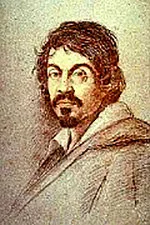
Self-portrait of Caravaggio
Caravaggio (c. 1571–1610) was an Italian Baroque painter who devoted himself to the painting of traditional religious themes.
Christ and the Apostles in the Garden (1604–1606) is a self-produced color reproduction of a destroyed, no-longer-existent artwork; previously, only black-and-white photographs survived it. The original artwork, painted by Michelangelo Merisi da Caravaggio, was “formerly in the Kaiser Friedrich Museum’s paintings gallery in Berlin but was destroyed in 1945. The subject is the episode related in Matthew 26, in which Jesus and his disciples went up to the Mount of Olives, outside Jerusalem, on the night that Jesus was arrested.”[1] This wonderful composition had caught the moment when Christ awakened his three sleeping apostles.
Jesus went with his eleven apostles to Gethsemane (Hebrew for “olive press”) to pray; he told them, “Sit here while I go over there and pray” (v. 36). He then took Peter, James, and John a little farther, telling them, “My soul is overwhelmed with sorrow to the point of death. Stay here and keep watch with me.” After praying, he returned to find all three sleeping. He awakened and rebuked Peter: “Couldn’t you men keep watch with me for one hour? Watch and pray so that you will not fall into temptation.” (vv. 40–41). Jesus went away to pray; all three times he found them sleeping. When he returned the third time he said, “Rise! Let us go! Here comes my betrayer!” (vv. 45–46).
… Height: 5 ft. 1 in. (154 cm), width: 7 ft. 3 in. (222 cm)
… Photo source, license, attribution, museum details, and image enlargement: Caravaggio, public domain, via Wikimedia Commons
… The artist’s short biography; his other works of art
Return to “Peter Masterpieces” album’s opening page or to the top of this page or open the next album. - 24. “The Agony in the Garden,” oil on pine panel, painted by Juan de Flandes, 1514–1519
The Agony in the Garden Netherlands painter Juan de Flandes or John of Flanders “probably came from Flanders county [Flandes in Spanish], as his conventional name suggests. Although the artist’s family name is not known for certain, he was first documented as ‘Juan de Flandes’ in 1496 at the court of Spain’s Queen Isabella of Castile and León, for whom he worked until she died in 1504. Thereafter, he fulfilled commissions for altarpieces.”[1]
“In keeping with the gospel according to Luke (22: 39–46), Christ is far from his other eight apostles as he kneels down near three close apostles; his hands are separated as he prays to the Father. He asks him to take away the ‘cup of suffering’ that he must drink, represented in this painting by the chalice atop the rock wall. The three apostles who accompany him — Peter, James, and John [l. to r.] — are asleep. The painting comes from the main altarpiece of the church of San Lázaro de Palencia, Spain.”[2] Behind Jesus, the artist shows the approach of Judas who leads members of the temple guard, illuminated by a lantern, who are about to arrest Jesus.
Note: The Spanish title of this painting, which appears in its footer — “Oración del Huerto” — is translated in English as “The Prayer of the Orchard.”
… Height: 43.3 in. (110 cm), width: 33 in. (84 cm)
… Photo source, license, attribution, museum details, and image enlargement: Museo del Prado
… The artist’s short biography; his other works of art
Return to “Peter Masterpieces” album’s opening page or to the top of this page or open the next album. - 25. “Jesus Christ on the Mount of Olives,” oil on oak panel, painted by Jan Gossaert, c. 1509
Jan Gossaert (c. 1478–1532) “was a French-speaking painter from the Low Countries, a coastal lowland region in Northwestern Europe. He was one of the first painters of Dutch and Flemish Renaissance painting to visit Italy and Rome, which he did in 1508–1509, and become a leader of the Romanism style. A contemporary of Albrecht Dürer, Gossaert achieved fame across at least northern Europe. He painted religious subjects, including large altarpieces.”[1]
Gossaert’s Jesus Christ on the Mount of Olives, sometimes titled The Agony in the Garden, depicts an unusually youthful Christ. Add to that the fact that the artist has brilliantly painted a nocturnal garden setting, illuminated solely by a soft moonlight glow. Traditional iconography includes three close apostles sleeping; Peter’s sword at hand; the “cup of bitterness” sitting atop a rock in reach of Christ; an angel capable of providing needed comfort to Jesus; and the approach of Judas (right) who leads a troop of armed temple guards prepared to arrest Jesus in Gethsemane when Judas kisses his Lord’s cheek.
What happened on the Mount of Olives? “The Mount of Olives was the site of many events in the Bible. Jesus made several visits there. The Bible records his visiting there three times in the last week of His earthly life, and each time something of significance happened: (1) his triumphal entry; (2) his deliverance of the Olivet Discourse; and (3) the night he agonized over his upcoming betrayal and crucifixion.”[2] The detailed accounts of this garden agony scene are presented in these three gospels: Matthew 26:36–46; Mark 14:32–42; Luke 22:39–46.
… Height: 33 1/2 in. (85 cm), width: 25 3/4 in. (63 cm)
… Photo source, license, attribution, museum details, and image enlargement: Jan Gossaert, public domain, via Wikimedia Commons
… The artist’s short biography; his other works of art
Return to “Peter Masterpieces” album’s opening page or to the top of this page or open the next album. - 26. “The Agony in the Garden,” oil on wood, painted probably by Lo Spagna, c. 1500–1505
Lo Spagna (‘the Spaniard’ in Italian) “was a High Renaissance painter, active in central Italy. Named Giovanni di Pietro, he was known as Lo Spagna because he was born in Spain. After Raphael, he was a main pupil and follower of the Umbrian painter Perugino, whose style his paintings develop.”[1]
“Christ kneels on a grassy hillock, hands folded in prayer, looking up at a floating angel who carries a cup. At the front, three of the apostles slumber, heads resting on their arms or hands. Soldiers wearing fantastic Renaissance versions of classical armor approach from the sides, led by Judas [right-hand group] who has betrayed Christ’s location to them. This depicts The Agony in the Garden, as told in Mark’s gospel (14: 32–43). At Gethsemane (Hebrew for “olive press”), Christ — knowing that he’s been betrayed and is to die — takes Peter, James, and John away from the other apostles and asks them to stand watch while he prays, asking God to ‘take this cup from me’ (v. 36). The apostles repeatedly fall asleep, failing to see the approaching soldiers, here led by Judas who carries a purse holding the 30 pieces of silver, given to him by the Jewish priests for leading them to Christ.
“This painting is based largely on Perugino’s Agony in the Garden (Uffizi Galleries, Florence) which was painted in the 1490s.”[2] Compare their obvious similarities and differences. See slide 4 on this Album 13 of Warren Camp’s “Peter Masterpieces” photo album.
… Height: 23.7 in. (60.3 cm), width: 26.5 in. (67.3 cm)
… Photo source, license, attribution, museum details, and image enlargement: The National Gallery, London
… The artist’s short biography
Return to “Peter Masterpieces” album’s opening page or to the top of this page or open the next album. - 27. “The Agony in the Garden,” tempera on panel, painted by Il Sassetta, 1437–1444
Stefano di Giovanni di Consolo, known as Il Sassetta (c.1392–c. 1450) was a Tuscan painter, considered one of the most important representatives of Sienese Renaissance painting. This Agony in the Garden panel was part of the Saint Francis Altarpiece, placed originally on the high altar of the St Francis church in Borgo San Sepolcro in Tuscany. According to the reconstruction of the now dismembered altarpiece, this panel was in the bottom-left corner of the polyptych’s back side. You can see where Il Sassetta’s Agony in the Garden panel had been located on the back side of the polyptych altarpiece.
The artist has included numerous traditional elements related to this Passion scene in his altarpiece panel: kneeling, praying Jesus being approached by a comforting angel holding the “cup of bitterness”; eight of Jesus’ apostles in the distance and the three select apostles nearby, all asleep; and Judas (center-rear) leading an approach of what would become many who’d arrest Jesus. The artist also gave all those in the foreground a golden halo.
Sassetta emphasized Jesus’ emotional isolation during prayer by showing him being approached by an angel holding that cup. “In Gethsemane’s garden, Jesus prayed to his Father three times, saying, ‘My Father, if it is possible, may this cup be taken from me. Yet not as I will, but as you will.’ (Matthew 26:39). A little later Jesus prayed, ‘My Father, if it is not possible for this cup to be taken away unless I drink it, may your will be done’ (v. 42). These prayers reveal Jesus’ mindset just before the crucifixion and His total submission to God’s will.”[1]
… Height: 17 1/8 in. (43.5 cm), width: 23.1/4 in. (59) cm)
… Photo source, license, attribution, museum details, and image enlargement: Sassetta, via Detroit Institute of Arts; Founders Society Purchase, Ralph Harman Booth Bequest Fund
… The artist’s short biography; his other works of art
Return to “Peter Masterpieces” album’s opening page or to the top of this page or open the next album.
- 28. “The Agony in the Garden,” oil on canvas, painted by Benvenuto Tisi da Garofalo, 1524
Benvenuto Tisi (1481–1559) “was a Late-Renaissance-Mannerist Italian painter of the School of Ferrara. His nickname, Il Garofalo, may derive from his habit of signing some works with a picture of a carnation (Italian, garofano). He painted extensively in Ferrara, in oil and in fresco.”[1]
“On the night before his crucifixion, Christ went to the garden of Gethsemane at the foot of the Mount of Olives in Jerusalem. He said his prayers but his disciples — James, Peter, and John [l. to r.] — fell asleep. While praying, Christ asked God if it was possible to spare him the agonizing destiny that awaited him. Eventually Christ accepted that God’s will must be done. An angel came from heaven to strengthen and comfort him.
“Garofalo depicts Christ at prayer while Judas [right-rear], who has betrayed him, brings the temple guard and others to arrest him. They arrive with flaming torches; Jerusalem’s buildings are visible behind them. An angel [left] appears in a light cloud, carrying a crucifix and a cup, representing the spilling of Christ’s blood, as illustrated in Christ’s prayer: ‘Father, if you are willing, take this cup from me; yet not my will, but yours be done’ (Luke 22:42).”[2] Note: There’s another painting of this subject by Il Garofalo, a vertical painting dated 1524–1526, that’s at The National Gallery, London. You can see it on slide 31.
… Height: 47 in. (119.4 cm), width: 60 in. (152.5 cm)
… Photo source, license, attribution, museum details, and image enlargement: Benvenuto Tisi, public domain, via Wikimedia Commons
… The artist’s short biography; his other works of art
Return to “Peter Masterpieces” album’s opening page or to the top of this page or open the next album. - 29. “The Agony in the Garden of Gethsemane,” oil on canvas, painted by Ludovico Carracci, c. 1590
Agony in the Garden of Gethsemane by Ludovico Carracci (1555–1619) “Ludovico was an Italian, early-Baroque painter, etcher, and printmaker born in Bologna.”[1] There are numerous Agony in the Garden paintings that Italian painters had painted. See this collection of more than seventy.
Herein, the three select “apostles sleep in the foreground, indifferent to the suffering of Christ who is attended by angels. One holds a chalice, prefiguring the Passion. The artist looked to Correggio (c. 1489–1534) in the treatment of the figures and folds of the drapery, which have details characteristic of a miniature. The canvas was in the Roman collection of the painter Carlo Maratta (1625–1713) and was acquired by Philip V in 1722.”[2]
Christ, in white, is portrayed in the center. Kneeling in Gethsemane, he’ll receive from three angels a cup, which the gospels present as the agonizing, imminent completion of Jesus’ human destiny. With his head down and his right arm supported by the closest angel, Jesus is away from his three sleeping apostles (Peter, James, and John). The artist has excluded traditional iconography of this scene: the other eight apostles; Jerusalem’s buildings and landscape in the background; and Judas Iscariot, leading a group of temple guard soldiers carrying torches, closing in to arrest Jesus. “The garden at Gethsemane, a place whose name literally means ‘oil press,’ is located on a slope of the Mount of Olives. Jesus frequently went there with His disciples to pray (John 18:2).”[3]
… Height: 20 in. (51 cm), width: 16 1/2 in. (42 cm)
… Photo source, license, attribution, and museum details: Ludovico Carracci, public domain, via Wikimedia Commons
… The artist’s short biography; his other works of art
Return to “Peter Masterpieces” album’s opening page or to the top of this page or open the next album. - 30. “Christ Praying in the Garden,” painted on panel by Marco Basaiti, 1510 or 1516
Marco Basaiti (active 1496–1530), “an admirer of Antonello da Messina and Giovanni Bellini, found himself fascinated at the beginning of the sixteenth century by the new artistic manner pioneered by Giorgione. This large panel painting is emblematic of the meeting-point of two of the finest ages of Venetian painting. Note: The doubt over the date of this panel painting is derived from a faded inscription. The represented saints on each side of the portico are Louis of Toulouse, Francis, Dominic, and Mark.”[1]
This large panel painting of Christ Praying in the Garden, by Basaiti, came from the church of Saint Job in Venice. Its altarpiece was commissioned by the House of Foscari. We learn from the gospels about Christ’s “prayer in the garden of Gethsemane” episode of Jesus’ Passion (Matthew 26:36–56; Mark 14:32–52; Luke 22:39–53; and John 18:1–11).
The depicted background scene is immersed in a landscape in which we find Christ, kneeling atop a rock with his head lifted heavenly, praying devotedly to Father God. Beneath this central focus we find James on his back, young John sitting above him, and Peter to the right, all asleep at the bottom of the hillock. Basaiti’s prayer scene is framed by a covered architectural space in which four standing saints meditate and read.
… Height: 12 ft. 2 in. (371 cm), width: 7 ft. 4 in. (224 cm)
… Photo source, license, attribution, museum details, and image enlargement: Marco Basaiti, public domain, via Wikimedia Commons
… The artist’s short biography; his other works of art
Return to “Peter Masterpieces” album’s opening page or to the top of this page or open the next album. - 31. “The Agony in the Garden,” oil on canvas, painted by Benvenuto Tisi da Garofalo, 1524–1526
Benvenuto Tisi (or Il Garofalo) (1481–1559) “was a Late-Renaissance-Mannerist Italian painter of the School of Ferrara. His nickname, Il Garofalo, may derive from his habit of signing some works with a picture of a carnation (Italian, garofano). He painted extensively in Ferrara, both in oil and in fresco.”[1] The author of altarpieces, Tisi is best known for his many small and carefully painted representations of religious subjects.
This smaller Agony in the Garden painting is from the National Gallery, London. You can see a previous 1524 Tisi painting of The Agony in the Garden (at the Birmingham Museum & Art Gallery in Birmingham, England) on slide 28. “Il Garofalo subsequently painted the same subject in 1525–1526 as an altarpiece for the Benedictine Church of San Silvestro in Ferrara (now in the Pinacoteca Nazionale, Ferrara); it’s likely that the National Gallery’s painting was a rehearsal for that commission, to test out some ideas in the vertical format. The painting was transferred from wooden panel to canvas before it entered the National Gallery’s collection.
“Da Garofalo depicts Christ at prayer while he places Judas [right-rear], who has betrayed him, bringing the temple guard and others with flaming torches to arrest him. An angel appears in a burst of light, holding a crucifix and a cup, representing the spilling of Christ’s blood. Jesus sensitively touches his heart and gathers his cloak, ready to confront his destiny.”[2] Note: There’s another painting of this subject by Il Garofalo, a horizontal painting dated 1524, that’s at Birmingham Museums Trust, UK. You can see it on slide 28.
… Height: 19.3 in. (49.2 cm), width: 15.2 in. (38.7 cm)
… Photo source, license, attribution, museum details, and image enlargement: Benvenuto Tisi (Da Garofalo), public domain, via Wikimedia Commons
… The artist’s short biography; his other works of art
Return to “Peter Masterpieces” album’s opening page or to the top of this page or open the next album.
- 32. “The Agony in the Garden,” mixed media on limewood, painted by Master of the Friedrich Altar, c. 1440
The Agony in the Garden was painted on a limewood altarpiece panel by Master of the Friedrichsaltar, a 15th-century court painter in the Austrian cities of Vienna and Wiener Neustadt. The “Friedrichsaltar” (also known as the Wiener Neustädter Altar in the Cathedral Church of St Stephan in Vienna) is a pentatych: a work of art consisting of five panels or sections. The shrine is decorated with sculptures, the front sides of the inner wings are decorated with reliefs, and the other sides of the wing present paintings. The Frederick Altar remained in its original location until the 19th century.
The composition is dominated by the division between the central figure of Christ kneeling on Gethsemane and the three sleeping apostles who adorn halos. The praying Christ has drops of bloody sweat (Luke 22:44) on hand and foot. An angel above Jesus presents him with the “cup of suffering.” The gospel accounts tell us that Christ retreated to a “place called Gethsemane” (Matthew 26:36; Mark 14:32; John 18:1) or “the Mount of Olives” (Luke 22:39) to pray; there he asked God to spare him the “cup of suffering” that he knew awaited him. The artist places in front of Jesus an angel holding a cross as well as the cup.
What happened at Gethsemane on the Mount of Olives? “The Mount of Olives was the site of a variety of events in the Bible. Jesus made several visits there. The Bible records his visiting there three times in the last week of His earthly life, and each time something of significance happened: (1) his triumphal entry; (2) his deliverance of the Olivet Discourse; and (3) the night he was betrayed.”[1]
… Height: 14 in. (35.7 cm), width: 10.6 in. (26.9 cm)
… Photo source, license, attribution, museum details, and image enlargement: Städel Museum
Return to “Peter Masterpieces” album’s opening page or to the top of this page or to the start of Warren Camp’s next page: Album 14.
“Peter” Has Indeed Left an Artistic Mark on Our World
In these albums, see numerous “Peter Masterpieces” created by renowned art masters from around the world.
• Album 1: “Peter, Alone” (29 images)
• Album 2: “Calling Apostle Peter” (12@), “Preaching the Gospel” (6@), and “Powerful Pentecost” (16@)
• Album 3: “Peter’s Presence with Other Apostles” (28@) and “Walking on Water” (7@)
• Album 4: “Receiving the Keys of Heaven” (15@), “Transfiguration” (8@), and “Tribute Money” (14@)
• Album 5: “Peter Heals People” (23@) and “The Miraculous Catch of Fish” (13@)
• Album 6: “Peter Gets Freed from Prison” (30@)
• Album 7: “Miscellaneous New Testament Depictions of Peter” (35@)
• Album 8: “Christ Washes Peter’s Feet” (26@)
• Album 9: “The Last Supper — Part 1” (33@ of 136)
• Album 10: “The Last Supper — Part 2” (35@ of 136)
• Album 11: “The Last Supper — Part 3” (34@ of 136)
• Album 12: “The Last Supper — Part 4” (34@ of 136)
• Album 13: “Christ’s Agony in the Garden” (32@)
• Album 14: “Judas’ Kiss,” “Jesus’ Betrayal,” and “Malchus’ Ear” (36@)
• Album 15: “Peter Denies Knowing Christ” (32@)
• Album 16: “Repentant Peter” (17@) and “Peter’s Martyrdom/Crucifixion” (17@)
• • • And, in Album 17, see “Stained Glass Windows Featuring Saint Peter” (34@)
Intro Videos: “First Peter” and “Second Peter”
† Watch this summary video of “First Peter” created by BibleProject.
† Here’s the “Second Peter” summary video created by BibleProject.
• Special Presentation: See more than sixty of Warren Camp’s “Peter Masterpieces” on this 4-minute video clip titled “Holy Week through 100 Paintings,” produced by Christian Art.
